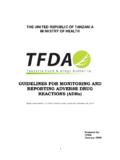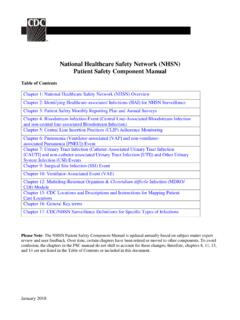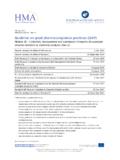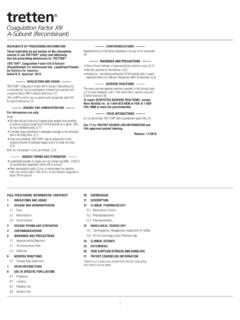Transcription of chapter 35 Pharmacovigilance - WHO
1 chapter 35 PharmacovigilanceSummary What is Pharmacovigilance and why is it important? adverse drug reactions Medication errors adverse drug Designing a Pharmacovigilance system activities at the facility level Pharmacovigilance activities at the national level Pharmacovigilance activities as part of public health programs Pharmacovigilance activities at the international Data collection data collection Mandatory data collection Active data collection Data collection Data analysis and reporting Taking actions for
2 Improvement and further readings guide 35-1 Analysis of medication errors in a hospital, 2005 35-2 Relationship of medication safety terms 35-3 Pharmacovigilance and the pharmaceutical management framework 35-4 The Pharmacovigilance framework 35-5 Nonvoluntary data collection tool for Pharmacovigilance 35-6 Sample ADE/product quality problem form from Zambia 35-1 Definitions of terms related to Pharmacovigilance 35-2 Determining ADR probability using indicators 35-3 Dangerous abbreviations 35-4 Roles and
3 Responsibilities of partners in Pharmacovigilance 35-5 Severity index for medication errors 35-1 Medication error caused by sound-alike products 35-2 Determining whether a medication error occurred 35-3 Safe medication practices studiesCS 35-1 Implementing an ADR reporting system in India 35-2 Standard operating procedures for aggregating ADR data and taking appropriate action in an ART program in Kenya I: Policy and economic issuesPart II: Pharmaceutical managementPart III.
4 Management support systemsSelectionProcurementDistributionU se27 Managing for rational medicine use28 Investigating medicine use29 Promoting rational prescribing30 Ensuring good dispensing practices31 Community-based participation and initiatives32 Drug seller initiatives33 Encouraging appropriate medicine use by consumers34 Medicine and therapeutics information35 Pharmacovigilancecopyright management sciences for health What is Pharmacovigilance and why is it important?WHO defines Pharmacovigilance as the science and activi-ties relating to the detection, assessment, understanding and prevention of adverse effects or any other medicine-related problem (WHO 2004, 1).
5 Terms related to the science of Pharmacovigilance are defined differently in different set-tings and by different organizations. The terms used in this chapter are defined in Table and more evidence is showing the huge effect of poor product quality, ADRs, and medication errors on health care, but estimating the actual scale of this effect is almost impossible because most cases go undetected. Much of the documented evidence available on medicine quality and ADEs comes from industrialized countries.
6 For example, in a bellwether report, the Institute of Medicine (IOM 2000) estimated that 7,000 or more people die each year from medication errors and ADRs and that the total costs may be between 17 billion dollars (USD) and USD 29 billion per year in hospitals nationwide. A follow-up report estimated that more than million Americans are injured every year by medication errors in hospitals, nursing homes, and doctor s offices (IOM 2006). ADEs also are costly in terms of loss of trust in the health care system by product quality, adverse drug reactions (ADRs), and medication errors greatly influence health care sys-tems by negatively affecting patient care and increasing costs.
7 Most of the statistics documenting the issues and highlighting the importance of Pharmacovigilance come from developed countries, therefore low- and middle-income countries likely have greater problems because of the poorer state of their health system infrastructure, the unreliable supply and quality of medicines, the lack of adequately trained essential health care staff, and their limited access to communication and information tech-nology. Three areas of Pharmacovigilance include Product quality adverse drug reactions Medication errorsProduct quality problem reporting systems are covered in chapter 19 on quality assurance.
8 This chapter focuses on the importance of ADRs and medication errors and actions to take to minimize their impact. An ADR is a harmful response caused by the medicine after the patient has received it in the recommended manner; whereas, adverse drug events (ADEs) result from either the medicine itself or the medicine s inappropriate use or medication professionals may still think of pharmaco-vigilance strictly in terms of identifying and reporting previously unknown and serious ADRs related to new products; however, Pharmacovigilance activities are related to every sector of the pharmaceutical manage-ment framework: selection, procurement, distribution, use, management support, and the overarching policy and legal framework.
9 Likewise, Pharmacovigilance activities are carried out at the facility, national, and international levels and require collaboration among a wide range of partners with differing responsibilities. National governments are responsible for ensuring that medicines sold in their countries are of good quality, safe, and effective. An important component of a country s ability to monitor pharmaceutical safety is a national Pharmacovigilance system that is supported by the drug regulatory authority. However, some countries have not included Pharmacovigilance as part of their legal frame-work.
10 Public health programs, such as those for treating HIV/AIDS and malaria, may have separate pharmaco-vigilance systems, while hospitals usually have the capac-ity to design and implement facility-based medication safety major components of a Pharmacovigilance system are data collection, which can be passive, active, or man-datory, and data analysis and reporting. When ADEs occur, they must be analyzed and reported and their significance must be communicated effectively to an audience that has the knowledge to interpret the infor-mation, including the national Pharmacovigilance center, if one exists, and the World Health Organization (WHO) Programme for International Drug Monitoring.
















